Reproduction
Regardless of the nesting strategy, the biology of reproduction is similar in all species. Females have two ovaries, and leading up to the nesting season, some follicles in the ovaries begin to grow. When the follicles are fully developed, each one will eventually form the yolk of an egg. The environmental stimulus for females to begin follicular development probably varies between species and environments. In areas with cold winter conditions, the higher temperatures of spring may be the stimulus. In areas where nesting occurs in the wet season, the first rains may act as a stimulus. These same environmental conditions may limit the extent of the nesting period. American alligators and Australian Freshwater Crocodiles are "pulse nesters" - all females within the population nest within a few weeks. Other species, such as Saltwater Crocodiles and New Guinea Crocodiles, are prolonged nesters, with the nesting season lasting six months or more.
The time between mating and egg-laying is about 3 weeks for American Alligators, but may be longer in some other species. With Saltwater Crocodiles housed together as pairs in captivity, a flourish of courting and mating behaviour starts about 4-6 weeks before egg-laying. At the time of mating, the yolk-filled eggs (ova) are still within the ovary. However, some time after mating the ova leave the ovary and enter the sperm-filled oviducts, where they are fertilised. The yolks become surrounded by a clear, jelly-like albumen, and later by a thick, leathery membrane. On the outside of this, the eggshell is deposited. Within the eggs, the embryos have already started to develop.
The extent of nest defence varies between species and within the one species in different geographic areas. With American Alligators, nest defence is associated with a suite of behavioural displays such as hissing, growling and body inflation. On the other hand, Saltwater Crocodiles tend to charge intruders immediately and will bite at anything within reach. Australian Freshwater Crocodiles have never been observed to defend their nests in the wild, but will occasionally do so in captivity. Female crocodilians tend to stay at or near the nest throughout incubation. Some species locate their nests next to permanent water, others dig wallows (that fill with water) in which they can lie next to the nest. Muggers excavate a burrow next to the nest site. At the time of egg-laying, the embryo is very small (about 5 x 1 mm), although it is reasonably well developed. It has a well defined head and brain, and a series of 10-20 muscle blocks (somites) from which the ribs and vertebrae will eventually form. The eggs are not moved by the female during incubation, and must thus be perfectly equipped to provide all the nutrients for the embryos to survive. Oxygen passes in and carbon dioxide out through the eggshell and eggshell membrane. The yolk supplies most of the food, and the albumen is essentially a water supply, although some nutrients are also contained within it. At laying, the hard-shelled eggs are translucent. However, within one day, a white opaque patch appears on the top (over the embryo), and begins extending down the sides as two arms. Within 7-10 days, there is a white opaque ring around the egg, and this remains in place until around half way through incubation, after which time it gradually spreads over the whole egg surface. This opacity is associated with structural changes in the eggshell membrane caused by activities being undertaken by the embryo within the egg (especially dehydration and utilisation of albumen). If the opacity does not develop at all, the egg is infertile or contains a dead embryo. If the opacity starts to develop and then stops, the embryo died after initial development. The rate at which embryos develop depends primarily on temperature, but can also be influenced by the gaseous (oxygen and carbon dioxide) and moisture environment within the nest. At 30°C, it takes 65 to 95 days to complete incubation, depending on the species. Incubation time is greatly extended at lower temperatures, and hastened at higher temperatures. Optimum incubation temperatures for all crocodilians are between 31 and 33°C. Temperatures between 34 and 35°C in the early part of incubation are lethal, or will cause a great variety of abnormalities. Development between 26 and 28°C is so slow that few embryos develop through to hatching - those that do have poor survivorship. The sex of all living crocodilians is determined by the incubation conditions, particularly temperature. Slow development (30°C or less) gives exclusively females. Incubation at around 31°C gives both sexes, whereas incubation between 32 and 33°C gives mostly males. Incubation at temperatures above 33°C continues to give males in some species, whereas in others sex reverts to females (high temperature females). Incubation temperature also affects the potential that hatchlings have for growth and survival, and "temperature-dependent sex determination" appears to be a mechanism for allocating maleness to those embryos with the greatest potential for attaining large size.
In response to hatchling calls, females usually excavate the nests, and may carry the newly hatched young down to the water in their mouths. The hatchlings group together in a “crèche” or “pod”, and the female may remain with it for months. Depending on the material from which the nest has been constructed, some hatchlings make their own way out, but this seems to be the exception rather than the rule. Females may actively assist the hatching process by rolling unhatched eggs within their mouths, gently squeezing them until they hatch. Sources: G. Webb and C. Manolis (1989): “Crocodiles of Australia” (Reed Books: Sydney); K. Richardson, G. Webb and C. Manolis (2000): “Crocodiles: Inside and Out” (Surrey Beatty and Sons: Sydney). |

 Email CSG
Email CSG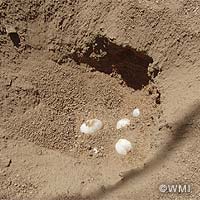
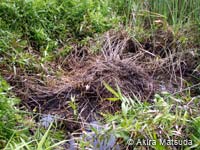
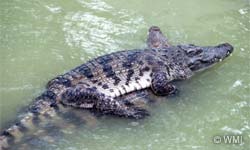 Mating is the culmination of a series of behavioural interactions between individuals, in which there are many submissive displays, including snout-rubbing. Mating has been observed many times, with many species, and always takes place in the water. The male lies over the back of the female and wraps his hind legs and tail under her, so that their cloacas (vents) come into contact. The single penis (many lizards and snakes have a hemipenis, thus two peni!) is inserted into the cloaca, and sperm is ejaculated into the two oviducts. During mating, the male and female, entwined together, may frequently submerge and resurface. Mating between a pair may occur once, or many times.
Mating is the culmination of a series of behavioural interactions between individuals, in which there are many submissive displays, including snout-rubbing. Mating has been observed many times, with many species, and always takes place in the water. The male lies over the back of the female and wraps his hind legs and tail under her, so that their cloacas (vents) come into contact. The single penis (many lizards and snakes have a hemipenis, thus two peni!) is inserted into the cloaca, and sperm is ejaculated into the two oviducts. During mating, the male and female, entwined together, may frequently submerge and resurface. Mating between a pair may occur once, or many times.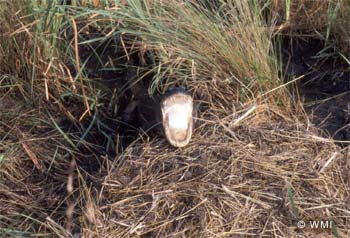 Females will often build or dig "trial" or "false" nests. For hole-nesters, these are series of holes which are abandoned after being dug. For mound-nesters, they are usually small, incomplete mounds. The females appear to be looking for a particular environment in which to lay their eggs. Egg-laying usually occurs at night and takes around 30-40 minutes. As the female is laying her eggs, she goes into a trance-like state and will usually not attempt to bite anyone disturbing her. When egg-laying is complete, the female covers the nest and usually becomes highly protective.
Females will often build or dig "trial" or "false" nests. For hole-nesters, these are series of holes which are abandoned after being dug. For mound-nesters, they are usually small, incomplete mounds. The females appear to be looking for a particular environment in which to lay their eggs. Egg-laying usually occurs at night and takes around 30-40 minutes. As the female is laying her eggs, she goes into a trance-like state and will usually not attempt to bite anyone disturbing her. When egg-laying is complete, the female covers the nest and usually becomes highly protective. 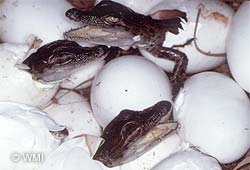 At the time of hatching, the fully developed hatchling embryos begin calling from within their eggs. On the tip of their snout they have an "egg-tooth" or caruncle, which develops from the skin. This is used to slice the eggshell membrane and then puncture the hard shell from the inside. The shell has already been structurally weakened by the time of hatching by the removal of calcium that had been incorporated into the developing embryo.
At the time of hatching, the fully developed hatchling embryos begin calling from within their eggs. On the tip of their snout they have an "egg-tooth" or caruncle, which develops from the skin. This is used to slice the eggshell membrane and then puncture the hard shell from the inside. The shell has already been structurally weakened by the time of hatching by the removal of calcium that had been incorporated into the developing embryo.